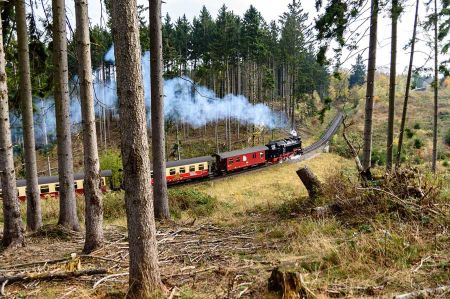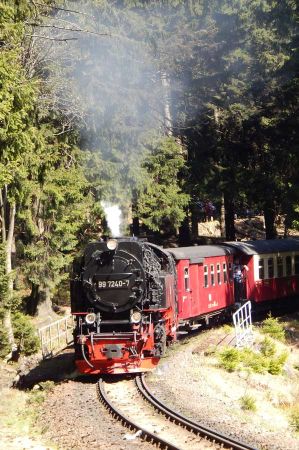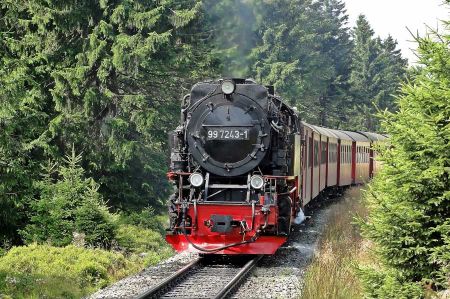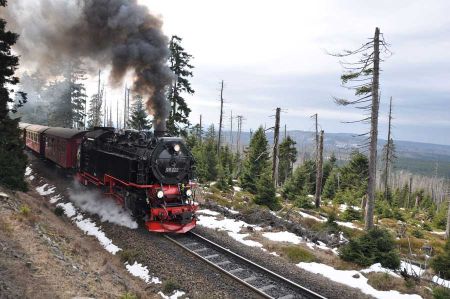Brockenbahn attractive in both summer and winter
- Written by Portal Editor
We are more fan of hiking up to the Brocken, but lot of people use the trains go up even in winter with six pairs of trains a day, if there are no Corona-related breaks.
And even if you don't opt for a train ticket, just watching the old steam locomotives of the Harz narrow-gauge railway is an adventure and always fascinating.
Plans to build a railway line up to the Brocken since 1869
As early as 1869 there was a draft for the construction of a railway to the Brocken, which was rejected by the responsible administration. A new attempt by Wernigerode in 1895, however, was successful; on May 30, 1896, the building permit was granted after Prince Otto zu Stolberg-Wernigerode had assigned the missing land. In 1897 a Brockenbahn was planned from Bad Harzburg via Torfhaus, which had already been officially approved, but failed due to public resistance (listen and be amazed - there were protests to preserve nature even then). The first section of the "Wernigeröder" Brocken Railway, from Drei-Annen-Hohne to Schierke, was opened on June 20, 1898; Served on October 15, in the winter half-year all trains ended at Schierke station.
 At the end of the Second World War, during fighting in the Harz, which had been declared a fortress, major damage to the route was mainly caused by bombs and grenades. The section to the Brocken was therefore not put back into operation until 1949.
At the end of the Second World War, during fighting in the Harz, which had been declared a fortress, major damage to the route was mainly caused by bombs and grenades. The section to the Brocken was therefore not put back into operation until 1949.
The operating company of the Brockenbahn was the Nordhausen-Wernigeroder Eisenbahn-Gesellschaft (NWE) until August 5, 1948, after which it belonged to the Association of Publicly Owned Enterprises (VVB) of Transport, Landesbahnen Sachsen-Anhalt and from April 11, 1949 to the Deutsche Reichsbahn. shortly after the German winter sports championships in 1950, which took place in Schierke, trains did run to the Brocken in winter. An Eckerloch train station was built for the championships, but it was abandoned after the championships and was just used as a stopping point if necessary. The location of the former sidings at Eckerloch train station can still be seen today.
Freight trains ran on the Brocken Railway until 1988. Up until this point in time, the trains still carried coal, oil and building materials up to the mountain for the border troops of the GDR and soldiers from the Soviet Union stationed there. The route had been in the restricted area since 1952 and a pass was required to enter. After the wall was built on August 13, 1961, passenger traffic between Schierke and the Brocken ceased on August 14. In passenger traffic, the Brocken Railway from Drei Annen Hohne to Schierke remained in operation, usually only two pairs of passenger trains per day; However, a pass was also necessary here, since Schierke was in the border area with the Federal Republic of Germany, too.
Routing and stations on the way to the Brocken
 Today the Brockenbahn is a mainly tourist-used, meter-gauge railway line that is still operated with steam locomotives of the so-called Harz narrow-gauge railways.
Today the Brockenbahn is a mainly tourist-used, meter-gauge railway line that is still operated with steam locomotives of the so-called Harz narrow-gauge railways.
The first station of the Brockenbahn leaves the Drei Annen Hohne station (542 m above sea level) next to the Harzquerbahn in a south-westerly direction. However, it crosses - still at the exit - the road to Schierke / Elend and then immediately drives into the Harz National Park, connected with an ascent of the route. Then it leads west to Schierke train station (688 m). About halfway through 1963 there was a siding to the granite quarry Knaupsholz. After leaving the Schierker train station, the route leads on a longer section through the valley of the Kalte Bode, which extends south and far below the route. The 971 m high Wurmberg appears to the left, and the train crosses Brockenstrasse for the first time.
After a tight left-hand bend in front of the Eckerlochbrücke and another right-hand bend, the route reaches Goetheweg station (956 m), which is now only used as a depot. The train then leads directly to the Brocken, circling it 1½ times in a spiral, crossing Brockenstrasse again, and finally ends in Brocken station (1,125 m) after 18.9 kilometres.
Conversion for tourist purposes after the fall of the wall
 After reunification, the Brocken Railway was initially questionable, but the combined efforts of railway enthusiasts and politicians led by Horst Rehberger, then Minister for Economic Affairs, gave the Brocken Railway a second chance. The Bundeswehr was also involved, as the Brocken Railway was needed to remove the superfluous military equipment on the Brocken. On September 15, 1991, after renovation, public transport on the Brocken Railway was ceremoniously reopened with two steam-powered trains. The locomotive 99 5903, a Mallet locomotive that the NWE procured in 1897/98, and the locomotive No. 99 6001, a prototype developed by the Krupp company in 1939, were used on the first train, and the 99 5902 on the second train and the 99 7244, a new construction locomotive for the Deutsche Reichsbahn.
After reunification, the Brocken Railway was initially questionable, but the combined efforts of railway enthusiasts and politicians led by Horst Rehberger, then Minister for Economic Affairs, gave the Brocken Railway a second chance. The Bundeswehr was also involved, as the Brocken Railway was needed to remove the superfluous military equipment on the Brocken. On September 15, 1991, after renovation, public transport on the Brocken Railway was ceremoniously reopened with two steam-powered trains. The locomotive 99 5903, a Mallet locomotive that the NWE procured in 1897/98, and the locomotive No. 99 6001, a prototype developed by the Krupp company in 1939, were used on the first train, and the 99 5902 on the second train and the 99 7244, a new construction locomotive for the Deutsche Reichsbahn.
Since the privatization of the narrow-gauge railways in the Harz in 1993, Brockenbahn has been operated by the Harzer narrow-gauge railways and is currently enjoying increasing popularity. As already said, we are more of the hikers and cyclists and still watch the steam locomotives coming and going with great interest.
Tourists asking: Are you interested in the job of a train driver? No, despite the enthusiasm, there was never really that wish.
Please read as well:
Zscheiplitz Monastery - a stopover on Unstrut cycle path
Frosty hike up to the Brocken at Harz Mountain
-
 Steam-Railway up to the Brocken Mountain
Steam-Railway up to the Brocken Mountain
Steam-Railway up to the Brocken Mountain
Steam-Railway up to the Brocken Mountain
-
 Steam-Railway up to the Brocken Mountain
Steam-Railway up to the Brocken Mountain
Steam-Railway up to the Brocken Mountain
Steam-Railway up to the Brocken Mountain
-
 Steam-Railway up to the Brocken Mountain
Steam-Railway up to the Brocken Mountain
Steam-Railway up to the Brocken Mountain
Steam-Railway up to the Brocken Mountain
-
 Steam-Railway up to the Brocken Mountain
Steam-Railway up to the Brocken Mountain
Steam-Railway up to the Brocken Mountain
Steam-Railway up to the Brocken Mountain
-
 Steam-Railway up to the Brocken Mountain
Steam-Railway up to the Brocken Mountain
Steam-Railway up to the Brocken Mountain
Steam-Railway up to the Brocken Mountain
-
 Steam-Railway up to the Brocken Mountain
Steam-Railway up to the Brocken Mountain
Steam-Railway up to the Brocken Mountain
Steam-Railway up to the Brocken Mountain
https://www.alaturka.info/en/germany/saxony-anhalt/5355-brockenbahn-attractive-in-both-summer-and-winter#sigProIdf7c0c60789

